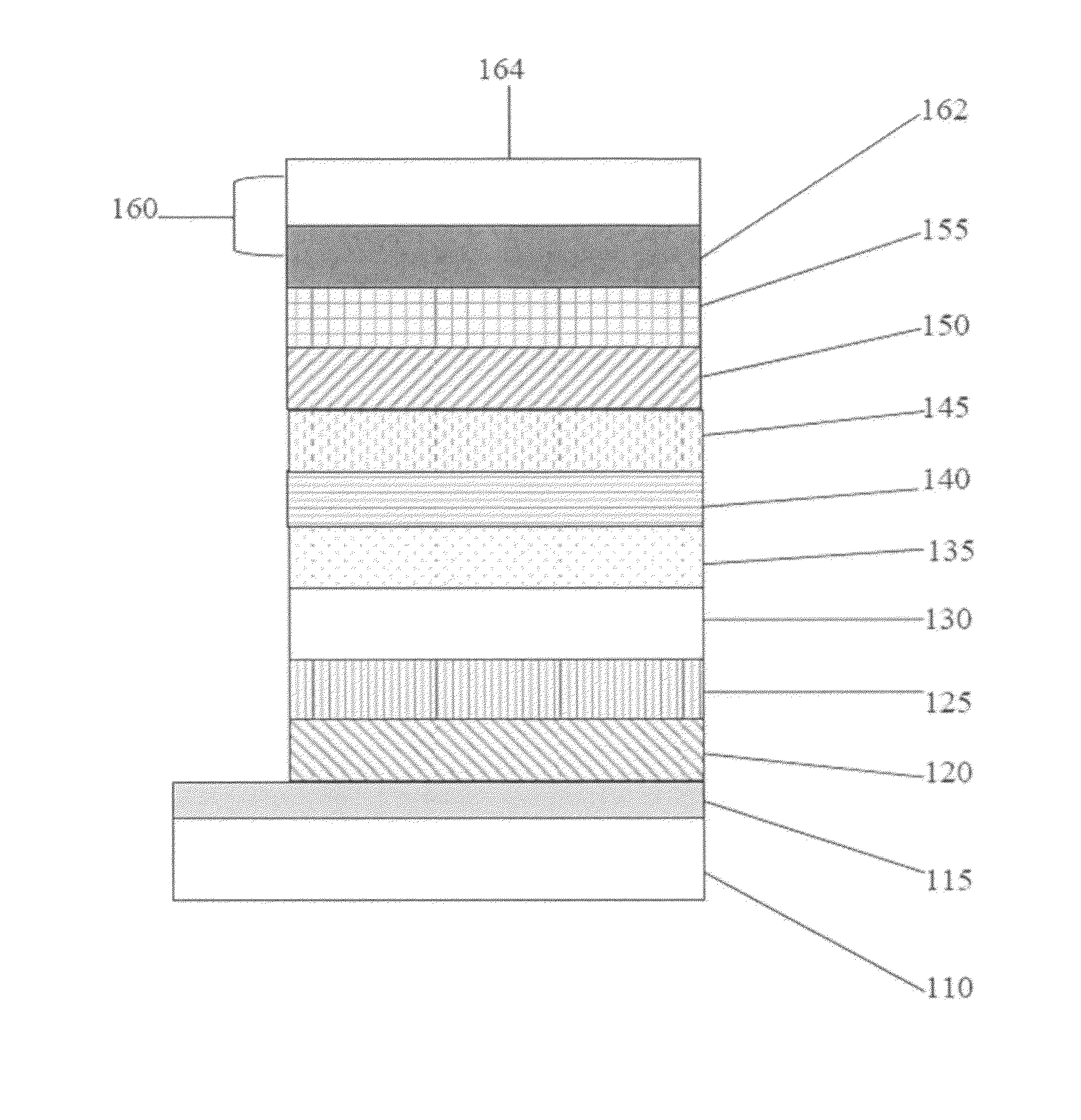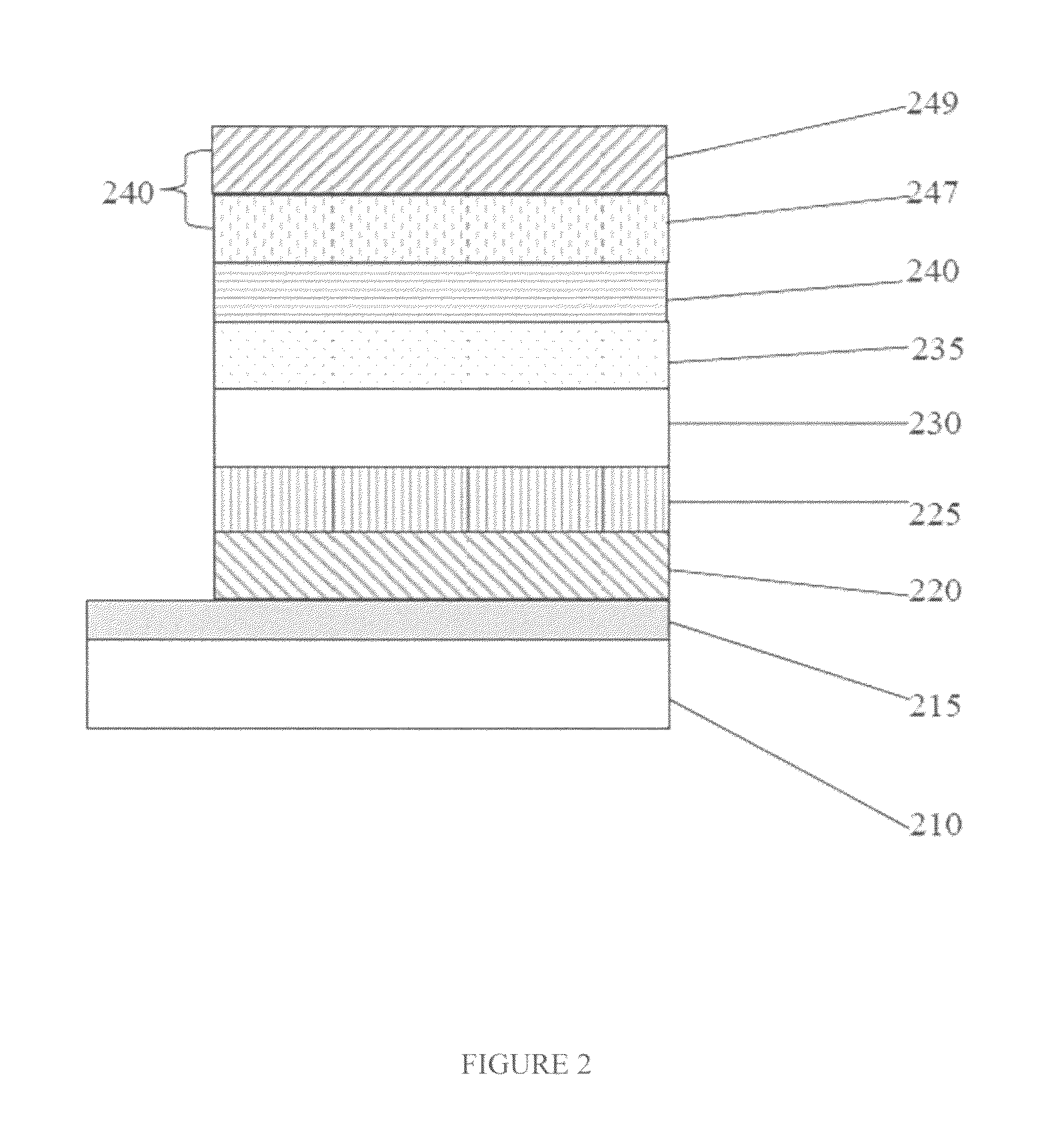High-energy triplet host materials, luminescent layer comprising the same, and organic electroluminescent device comprising the luminescent layer
a technology of host materials and luminescent layers, applied in the direction of luminescnet screens, natural mineral layered products, organic chemistry, etc., can solve the problems of partly preventing the application of deep blue phosphorescence dopants, and achieve the effect of improving the emissive and host charge-transport properties, high energy of singlet and triplet excited states, and improving the charge-transport properties
- Summary
- Abstract
- Description
- Claims
- Application Information
AI Technical Summary
Benefits of technology
Problems solved by technology
Method used
Image
Examples
example 1
Synthesis of 1,3,5-tris[1-(4-bromophenyl)-1H-benzo[d]imidazol-2-yl]benzene (Compound 1)
[0118]
[0119]N-(4-bromophenyl)-1,2-phenylenediamine (1.64 g, 6.23 mmol) was dissolved in 1-methyl-2-pyrrolidinone (NMP) (7 mL). To the solution 1,3,5-benzenetricarbonyl trichloride (0.551 g, 2.08 mmol) was added portion-wise under nitrogen. The reaction mixture was stirred at room temperature for 2 h, and then the reaction temperature was raised to 50° C. for additional 30 min. After cooling the reaction mixture was poured into cold water (50 mL). The resulting precipitates were filtered off and washed with water to give crude tribenzamide. The tribenzamide was heated at 250° C. for 3 h under nitrogen. After cooling water (50 mL) was added to the mixture, and extracted with CH2Cl2 (50×3 mL). The combined organic layers were washed with water and brine, and then dried over Na2SO4. Solvent of the filtrate was removed in vacuo to obtain a crude solid. 1,3,5-Tris[1-(4-bromophenyl)-1Hbenzo[d]imidazol-2-...
example 2
Synthesis of 4,4′,4″-[2,2′,2″-(benzene-1,3,5-triyl)-tris(1H-benzo[d]imidazole-2,1-diyl)]-tris(N,Ndiphenylaniline) (Compound 2)
[0120]
[0121]A mixture of 1,3,5-tris[N-(4-bromophenyl)benzimidazol-2-yl]benzene (0.500 g, 0.560 mmol), diphenylamine (0.570 g, 3.36 mmol), Pd(OAc)2 (0.220 mmol), P(t-Bu)3 (0.900 mmol), NaOtBu (0.480 g, 4.99 mmol) in toluene (5 mL) was refluxed at 110° C. for 70 h under nitrogen. To the reaction mixture water (50 mL) was added, and extracted with CH2Cl2 (50×3 mL). The combined CH2Cl2 layers were washed with water, and dried over Na2SO4. The solution was filtered and the solvent was removed in vacuo. The residue was subjected to column chromatography on silica gel (solvent: EtOAc / CH2Cl2=1 / 2 followed by 1 / 1) to afford Compound 2 (0.598 g, 92%). 111 NMR (300 MHz, CDCl3, δ): 7.89-7.91 (m, 6H), 7.33-7.42 (m, 9H), 6.87-7.00 (m, 42H); 13C APT NMR (75.5 MHz, CDCl3, δ): 151.2 (C), 148.6 (C), 147.2 (C), 143.2 (C), 137.3 (C), 131.3 (CH), 130.7 (C), 129.9 (C), 129.5 (CH), ...
example 3
Synthesis of 1,3,5-tris(1-(4-(9H-carbazol-9-yl)phenyl)-1H-benzo[d]imidazol-2-yl)benzene (Compound 3)
[0122]
[0123]A mixture of 1,3,5-tris[N-(4-bromophenyl)benzimidazol-2-yl]benzene (0.800 g, 0.897 mmol), carbazole (0.900 g, 5.38 mmol), CuI (0.049 g, 0.256 mmol), 18-crown-6 (0.093 g, 0.352 mmol) and K2CO3 (1.10 g, 7.99 mmol) was heated in 1,3-dimethyl-3,4,5,6-tetrahydro-2(1H)-pyrimidinone (DMPU) (2 mL) at 210° C. for 64 h under nitrogen. After cooling, 1 N HCl (60 mL) was added to the reaction mixture and extracted with CH2Cl2 (100×3 mL). The combined organic layers were washed with 15% NH4OH (100 mL), water (100 mL), and brine (100 mL). Then, the solution was dried over Na2SO4, and filtration, followed by evaporation of solvent in vacuo, gave a brown oil. Compound 3 was isolated by silica gel column chromatography (solvent: EtOAc / CH2Cl2=1 / 2) (0.490 g, 44%). 1H NMR (300 MHz, CDCl3, 8): 8.13 (s, 3H), 8.06 (d, J=7.8 Hz, 6H), 7.91 (d, J=7.8 Hz, 3H), 7.60 (d, J=8.7 Hz, 6H), 7.36-7.46 (m, 1...
PUM
| Property | Measurement | Unit |
|---|---|---|
| triplet energy | aaaaa | aaaaa |
| triplet energy | aaaaa | aaaaa |
| triplet energy | aaaaa | aaaaa |
Abstract
Description
Claims
Application Information
 Login to View More
Login to View More - R&D
- Intellectual Property
- Life Sciences
- Materials
- Tech Scout
- Unparalleled Data Quality
- Higher Quality Content
- 60% Fewer Hallucinations
Browse by: Latest US Patents, China's latest patents, Technical Efficacy Thesaurus, Application Domain, Technology Topic, Popular Technical Reports.
© 2025 PatSnap. All rights reserved.Legal|Privacy policy|Modern Slavery Act Transparency Statement|Sitemap|About US| Contact US: help@patsnap.com



